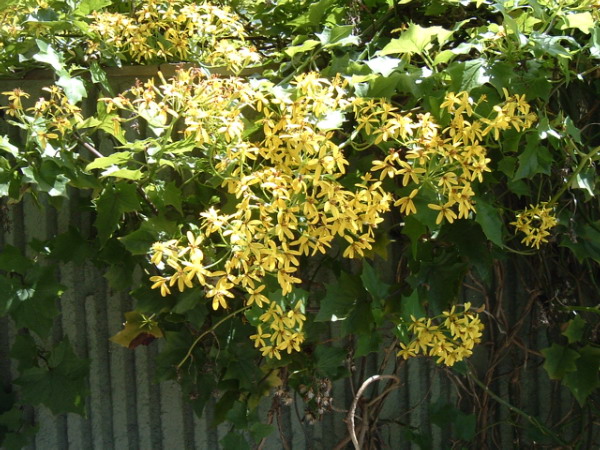- Senecio tamoides
Taxobox

image_caption = Creeping groundsel
image_width = 260px
regnum =Plant ae
divisio =Magnoliophyta
classis =Magnoliopsida
ordo =Asterales
familia =Asteraceae
tribus =Senecioneae
genus = "Senecio "
species = "S. tamoides"
binomial = "Senecio tamoides"
binomial_authority = DC. (1838)cite web
url = http://www.ars-grin.gov/cgi-bin/npgs/html/taxon.pl?33704
title = Taxon: "Senecio tamoides" DC.
accessdate = 2008-04-14
author = Germplasm Resources Information Network (GRIN)
authorlink = Germplasm Resources Information Network
date = 1985-11-07
format = HTML
work = Taxonomy for Plants
publisher = USDA, ARS, National Genetic Resources Program, National Germplasm Resources Laboratory, Beltsville, Maryland ] cite web
url = http://floraseries.landcareresearch.co.nz/pages/Taxon.aspx?id=_50e4f74e-a0b2-4dbe-9d34-112367ca3cbf&fileName=Flora%204.xml
title = Senecio angulatus L.f. Suppl. 369 (1781)
accessdate = 2008-04-01
author = Landcare Research
authorlink = Landcare Research New Zealand Limited
format = HTML
work = Flora of New Zealand: Taxa
publisher =Landcare Research Allan Herbarium andNew Zealand Plant Names Database ]
range_
range_map_width = 260px
range_map_caption = Range of "S. tamoides"
synonyms ="Senecio tamoides" or also known as Canary creeper (a name it shares with "Senecio deltoideus" Less.cite web
url = http://www.zimbabweflora.co.zw/cult/species.php?species_id=161400
title = "Senecio deltoideus" Less.
accessdate = 2008-04-14
last = Hyde
first = Mark
coauthors = Bart Wursten
format = HTML
work = Flora of Zimbabwe] ) is a climbing member of the genus "Senecio " of the familyAsteraceae .cite web
url = http://www.zimbabweflora.co.zw/speciesdata/species.php?species_id=161400
title = "Senecio tamoides" DC.
accessdate = 2008-04-14
last = Hyde
first = Mark
coauthors = Bart Wursten
format = HTML
work = Flora of Zimbabwe: Cultivated plants]Description
Scramblingcite web
url = http://plantnet.rbgsyd.nsw.gov.au/cgi-bin/NSWfl.pl?page=nswfl&lvl=sp&name=Senecio~tamoides
title = PlantNET "Senecio tamoides" DC.
accessdate = 2008-04-14
author = National Herbarium of New South Wales
authorlink = National Herbarium of New South Wales
format = HTML
work =New South Wales FloraOnline
publisher =Royal Botanic Gardens, Sydney ] mostly evergreencite book
last = Pienaar
first = Kristo
title = Gardening with Indigenous Plants: Easy to Grow Southern African Plants
url = http://books.google.com/books?id=UIuW4WTbAPYC&lr=&source=gbs_summary_s&cad=0
format = HTML
accessdate = 2008-04-14
year = 2003
publisher = Struik
isbn = 1868723925
pages = 96 pages
chapter = Climbers
chapterurl = http://books.google.com/books?id=UIuW4WTbAPYC&pg=PA80&lr=&source=gbs_search_s&sig=le7aGn6b62eLP14VKBigk89jpf4] perennial, creeping along the ground or climbing several meters into the trees.Stems and leaves:Slender and hairless stems, up to convert|2|m|ft|lk=on tall.
Bright green leaves shaped like many ivy with broad, oval, and fleshy leaf surfaces convert|4|cm|in|lk=on long and convert|7|cm|in wide, coarsely toothed edges, leaf stalks convert|2|cm|in to convert|5|cm|in long.
Flowers:Inflorescence is a many-headed, bright yellow, and the flowering spike grows to have a flat top. The flower heads are cylindrical, about convert|3|mm|in|lk=on in diameter; surrounded with a whorl of five to seven bracts, convert|6|mm|in to convert|7|mm|in long which are surrounded by two to four smaller bracts or bracteoles. Three to six ray florets; each ligule approximately convert|1|cm|in long; ten to twelve disc florets, convert|12|mm|in to convert|15|mm|in long.
When cultivated in the gardens of the National Museums of Kenya, it has orange florets.cite web
url = http://www.aluka.org/action/showMetadata?doi=10.5555/AL.AP.FLORA.FTEA006390&pgs=
title = Entry for "SENECIO tamoides" DC. [family COMPOSITAE]
accessdate = 2008-04-14
author = Aluka
authorlink = Aluka
format = HTML
work = African Plants
publisher = Ithaka Harbors, Inc]Fruits and reproduction:
Achenes about convert|2|mm|in long, and not hairy; pappus convert|6|mm|in to convert|7|mm|in long. It grows easily from stem cuttings.Distribution
Along evergreen forest margins at altitudes of convert|300|m|ft|lk=on to convert|1900|m|ft and in moist gullies.
References
Wikimedia Foundation. 2010.
